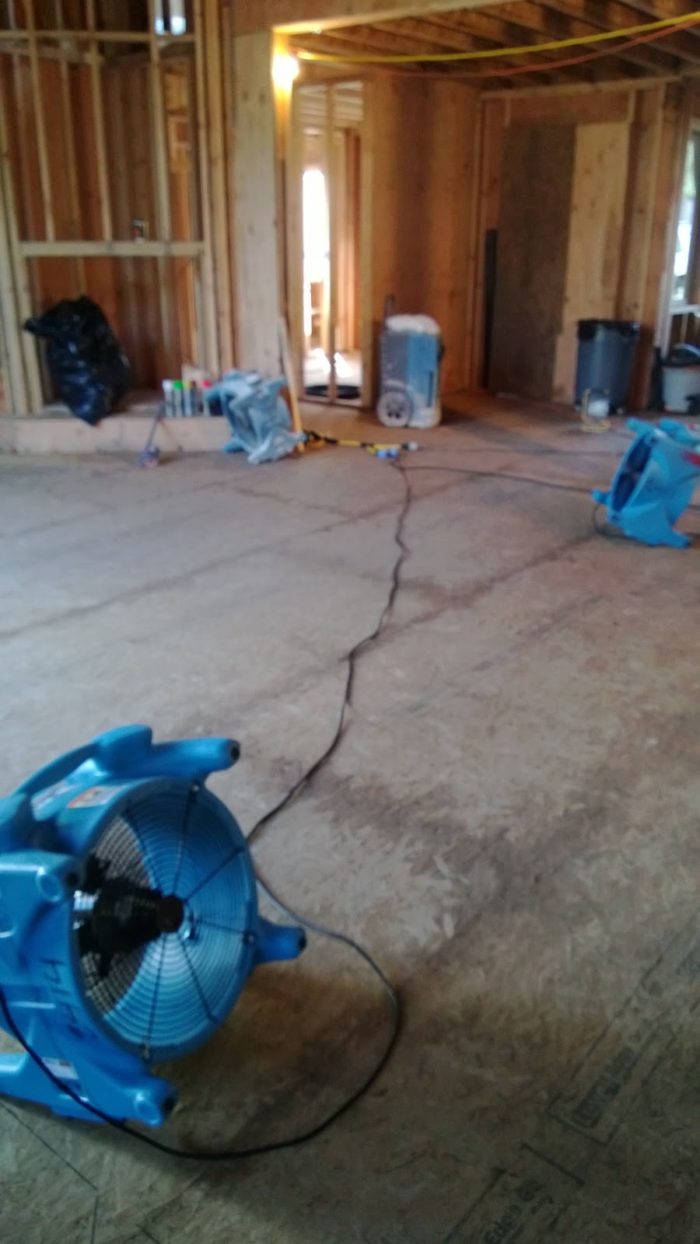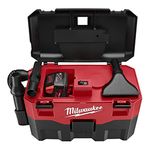Drying Wet Framing Lumber
A moisture-meter reading above 18% means the framing's too wet; use one (or more) of these four options to dry it out.

This is a follow up to my first post titled Pre-Drywall Moisture Meter Check. What do you do if you have wet framing lumber?

First, if you see standing puddles and soaked framing, don’t move onto the next stage of construction! Next, pull out your moisture meter and map the house.

If your moisture meter is reading 18%+ on the framing it’s too wet and needs to dry. So. how do we get that number to the 12%-14% range that I want to see prior to hanging sheetrock? (ideally all 12% or less)
There are 4 tools you can use to dry your wet framing lumber. Time, Air movement, De-humidification, and Heat.
1. Time. Given enough time (assuming it’s not getting wet again) that wet lumber will naturally dry. If the outdoor temps are above 60 degrees F then it won’t take much time. Maybe 3-5 weeks to get from 18% down to 14%. But, if it’s cold & rainy outside it might take 6-12 weeks. If it’s below 32 degrees F it will take a loooong time to dry.
2. Air movement. This is the first and easiest tool in the drying toolbox. I own several carpet blower fans and I highly recommend every builder in every climate own a few of these.


The easiest and cheapest way to dry a wet framed house is to set up fans to blow on the wet areas of the house. I’ve found that if the weather is above 45 degrees F during the day then a fan blowing on a wet area of framing will dry down about .5-1% per day. So if you’re getting moisture meter readings in the 18-20% range you’ll need a solid week of drying fans to get the numbers down to the 14% and below range. (Read on if you have lower outdoor temps you are dealing with.)
When I do this process I chain/padlock the fans to the framing and run them 24/7 till I’m done.
3. De-humidification. I also am a big proponent of builders owning dehum equipment. Here’s a job site photo of my Dri-Eaz LGR Evolution.


Blowing air will work to a certain extent, but controlling the humidity is the key to really drying down your framing. If the air outside is above 60% humidity I recommend shutting down your windows/doors and running your fans in combination with a dehumidifier like mine above.
4. Heat. After I posted my last blog post on moisture meter testing I got asked by several Northern builders about wet & frozen lumber. This is really where the heat is needed. But, we can’t just use any heat source. It’s common to see propane heaters on the job site for temporary heat, but these aren’t good for drying purposes. Consider that a typical propane heater adds 1 gallon of moisture to the air for every hour of run time. What you really need is combustion OUTSIDE the house and dry/hot air blowing in.

I hope this primer on drying has helped. Please comment if you have an input or other ideas/suggestions on drying techniques.
Best,
Matt Risinger
Risinger Homes in Austin TX
Risinger Homes is a custom builder and whole house remodeling contractor that specializes in Architect driven and fine craftsmanship work. We utilize an in-house carpentry staff and the latest building science research to build dramatically more efficient, healthy and durable homes.
Be sure to check out my video blog on YouTube.
Fine Homebuilding Recommended Products
Fine Homebuilding receives a commission for items purchased through links on this site, including Amazon Associates and other affiliate advertising programs.

Not So Big House

The New Carbon Architecture: Building to Cool the Climate

Milwaukee Cordless Shop Vac (0880-20)







View Comments
See the part 1 of this post here. https://www.finehomebuilding.com/item/26842/what-happens-if-your-framing-gets-rained-on-learn-to-use-a-moisture-meter
thanks for the tip, living in a rain forest, this sould help alot of my projects
Interesting article, thanks. Could you describe the system shown in the last photo? (Manufacturer, model, etc.) Thanks.
@rkammeraad: That mobile furnace is from Dri-Eaz and it puts out 85,000BTU of dry heat. The model in the picture is discontinued. The replacement is called the "Dragon X2" and it's a 100,000BTU model, mounted on a trailer! http://amzn.to/Wj6KqC
Thanks for commenting, Matt
I wish we had 45 degree weather in Florida. With the year-round humidity, this is a constant issue. The dehumidifier and fans are great tips. Thanks.
Matt, great article. Due to Hurricane Harvey, I had some relatively minor water intrusion into my home through the weep holes in the brick. It was approximately 2 weeks before I caught on since no water was seen coming into the home. The water apparently ran along the sill plate, wetting them along with the back of the base boards and some sheetrock. Everything is opened up but I have a question for you. The sills feel and look dry and with my pin-type meter I receive a dry reading. However with a pinless meter I am getting very wet readings in some areas. The pinless meter claims to read to a depth of 3/4" vs the very shallow measuring depth of my pin-type meter. Is the bulk of the moisture trapped between the slab and the sill plate? Which meter should I rely more heavily on? And might there be a pro-tip to speeding up drying of the bottom half of the sill?